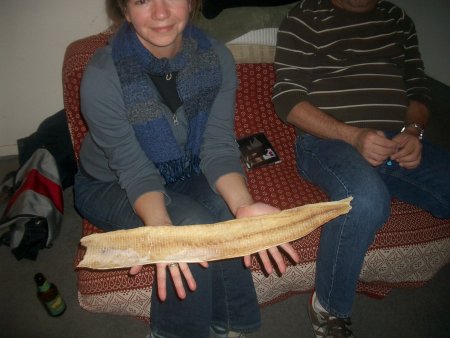In this blog I have often explored the esoteric cuisine’s of other cultures, but rarely have I had the chance to frak food from my own heritage. Yesterday, Julia and I drove three hours into the Texas hinterland for the chance to taste lutefisk.
For those of you who are not of Norwegian descent, you have probably only heard lutefisk mentioned as a passing joke on NPR’s "Prairie Home Companion." Lutefisk is cod that has been cured in lye. Cooking and re-hydration makes it edible, but it’s general knowledge that it never tastes particularly good. My grandfather made it for the family once, over Christmas, and I distinctly remember it tasting like a bowl of fish Jello.
But Norwegian-Americans don’t eat lutefisk because it tastes good. Eating lutefisk over the holidays is an act of communion. It’s a way to remember the hardships of ancestors who crossed an ocean looking for a better life.
In Minnesota and Wisconsin, lutefisk can be acquired through a few specialty shops, theme restaurants, and yearly church dinners. In Texas, to my knowledge, you can only get lutefisk at the annual lutefisk dinner in Cranfills Gap.
I was feeling sad that I wasn’t going to be seeing too much of my family this year, so I went online and found this dinner. Cranfills Gap is part of a Norwegian enclave somewhat west of Waco. For years they have been throwing the lutefisk dinner as a fundraiser for the school’s sports teams.
So I filled out the PDF form and mailed in my check. The school secretary mailed me back with my tickets and a letter with the school’s phone number and her home number too, just in case I had any questions.

Cranfills Gap is about an hour and a half from any major highway, and the googlemaps directions had us driving through the sketchiest one-lane backroads you can imagine, but we got there eventually. While we waited to be seated at the dinner, we sat in the school gymnasium, where they had a little ethnic fair. I bought a recipe book from the booth run by the local Methodist church. They also had children and old folks in traditional garb performing traditional folk dances. You know, like the chicken dance.
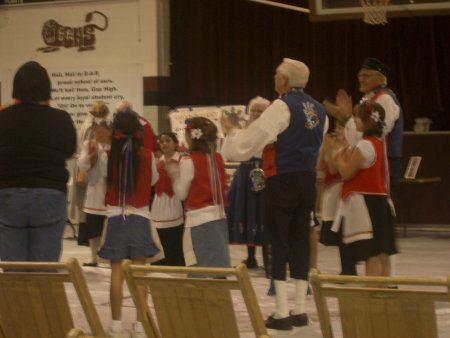
Then we were seated in the school cafeteria, where high school girls in traditional Norwegian waitress costumes bustled about with handkerchiefs pinned over their head. The meal was served "family style" which meant sitting at the long cafeteria tables with a bunch of strangers and asking them to pass the gravy and potatoes. Which worked out pretty well. Everyone was friendly and helpful. It was sometimes a little quiet, but that’s to be expected with a table full of Norwegian-Americans who don’t know each other and are having a very serious moment reaffirming their heritage by eating as much as they can. Most of the people weren’t actually from the town. Some had driven down from Dallas because their grandparents had lived in Cranfills Gap and they weren’t ready to leave the traditions behind.
There was plenty of side dishes, gravy, and turkey. And when you sat down at an empty spot there was already a slice of pie waiting for you. But everyone was there for the lutefisk. People would say, "Would you please pass The Fish," or "You’re giong to want some white sauce for The Fish," with subtly inflected capitals.
The lutefisk itself was devilishly difficult to photograph. It has virtually no color. And hardly any taste really. It was slightly gelatinous, slightly fishy, and mainly bland. Here’s a couple of photos with different color settings so you can get an idea for what it looked like.
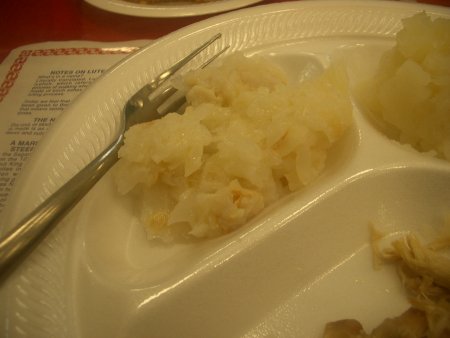
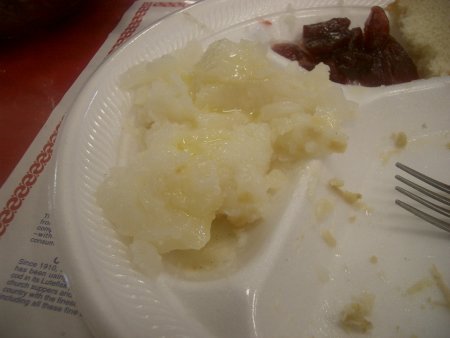
After the dinner, Julia and I went to the back of the school to the "fish shack," a building which I presume was made specifically for the preparation and storage of a notoriously difficult and smelly food. The shack has two doors toward the back. One door is stainless steel and leads to a refrigeration unit and the pre-prepared lutefisk. The other door is made from barn wood and sits crooked on its hinges. This is where they keep the dried and unprepared lutefisk. The girl who went back there to fetch me a half pound of uncooked lutefisk brought it out unwrapped in her bare hands. They gave me a bag for it as an afterthought, just so it would be easier to carry.
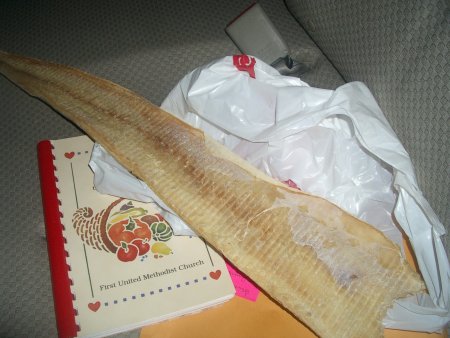
Not that it actually fit in the bag. But not to worry, in this stage it’s technically not a food product. Technically it’s a toxin.
Once back in Austin, Julia and I went to a party, where I passed around the lutefisk. It was indeed the hit of the party.
